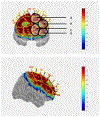Impaired neurovascular coupling in metabolic syndrome: an fNIRS study
- PMID: 40387835
- PMCID: PMC12313023
- DOI: 10.1152/japplphysiol.00893.2024
Impaired neurovascular coupling in metabolic syndrome: an fNIRS study
Abstract
The mechanisms underpinning accelerated cognitive decline in metabolic syndrome (MetS) are poorly understood. Neurovascular coupling (NVC) is the coordinated matching of blood flow to neuronal activation and is dependent on endothelial function. NVC may drive blood flow dysregulation that contributes to neuronal damage and cognitive decline. The purpose was to assess NVC, peripheral endothelial function, and cognitive performance in older adults with MetS and healthy controls (CON), and the association of these factors. Older adults with and without MetS were recruited to complete a neurocognitive battery, assessment of NVC, and endothelial function. NVC was measured in the frontoparietal regions using functional near infrared spectroscopy (fNIRS) while participants completed the n-back task (0-, 1-, 2-back). Changes in oxyhemoglobin (HbO) and deoxyhemoglobin (HbR) signals reflected NVC during the n-back task. Endothelial function was measured using brachial ultrasound measurements of flow-mediated dilation (%FMD). MetS (n = 22; age: 66 ± 6 yr) demonstrated poorer NVC during higher cognitive loads, reflected by an attenuated increase in HbO in the premotor cortex during the 2-back task compared with CON (n = 26; age: 64 ± 5 yr) (P = 0.036). MetS also demonstrated poorer FMD (5.55 ± 1.35% vs. 4.42 ± 1.71%, P = 0.01) and 2-back accuracy compared with CON (MetS: 81.7 ± 6.4%; CON: 86.0 ± 6.1%, P = 0.027), with a significant positive association between these two factors (r = 0.37, P = 0.012). Impairments in NVC of the frontal cortex may be an early cerebrovascular mechanism underpinning cognitive decline in MetS and is discernible during higher cognitive loads. Peripheral endothelial dysfunction may be implicated in this mechanism.NEW & NOTEWORTHY Deficits in neurovascular coupling (NVC) precede neuronal damage and subsequent cognitive deficits, encompassing the vascular contributions to cognitive decline framework. Older adults with metabolic syndrome (MetS), a prevalent population, present with accelerated cognitive decline, however, changes to NVC in MetS had not been studied. We demonstrate that older adults with MetS exhibit reduced NVC during higher cognitive loads compared with healthy older adults, which corresponds with poorer working memory performance, and may involve endothelial dysfunction.
Keywords: VCID; cerebrovascular; cognition; metabolic syndrome; neurovascular coupling.
Conflict of interest statement
Figures







Similar articles
-
Impact of acute sleep restriction on cerebrovascular reactivity and neurovascular coupling in young men and women.J Appl Physiol (1985). 2025 Jan 1;138(1):282-288. doi: 10.1152/japplphysiol.00648.2024. Epub 2024 Dec 11. J Appl Physiol (1985). 2025. PMID: 39661323 Free PMC article.
-
Diminished Locomotor Control Is Associated With Reduced Neurovascular Coupling in Older Adults.J Gerontol A Biol Sci Med Sci. 2020 Jul 13;75(8):1516-1522. doi: 10.1093/gerona/glz006. J Gerontol A Biol Sci Med Sci. 2020. PMID: 30629129 Free PMC article.
-
Neurovascular coupling, functional connectivity, and cerebrovascular endothelial extracellular vesicles as biomarkers of mild cognitive impairment.Alzheimers Dement. 2024 Aug;20(8):5590-5606. doi: 10.1002/alz.14072. Epub 2024 Jul 3. Alzheimers Dement. 2024. PMID: 38958537 Free PMC article.
-
Associations between neurovascular coupling and cerebral small vessel disease: A systematic review and meta-analysis.Eur Stroke J. 2023 Dec;8(4):895-903. doi: 10.1177/23969873231196981. Epub 2023 Sep 11. Eur Stroke J. 2023. PMID: 37697725 Free PMC article.
-
The Black Book of Psychotropic Dosing and Monitoring.Psychopharmacol Bull. 2024 Jul 8;54(3):8-59. Psychopharmacol Bull. 2024. PMID: 38993656 Free PMC article. Review.
References
-
- Expert Panel on Detection, Evaluation and T of HBC in A. Executive Summary of the Third Report of the National Cholesterol Education Program (NCEP) Expert Panel on Detection, Evaluation, and Treatment of High Blood Cholesterol in Adults (Adult Treatment Panel III). JAMA J Am Med Assoc 2001;285:2486–97. 10.1001/jama.285.19.2486. - DOI - PubMed
MeSH terms
Substances
Grants and funding
LinkOut - more resources
Full Text Sources
Medical

